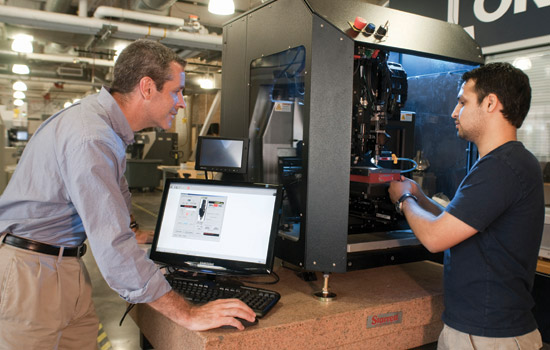RIT announces partnership with high-tech firms
University-industry collaboration strengthens high-growth 3-D printed electronics industry
Provided by Research at RIT magazine
Denis Cormier, left, professor of industrial and systems engineering, is developing novel approaches to fuel-cell production through advanced manufacturing processes. He led a workshop series recently in the Earl W. Brinkman Lab in RIT’s Kate Gleason College of Engineering to demonstrate advanced manufacturing equipment recently acquired by the university.
Printed electronics and related advanced manufacturing technologies have the potential to be a $45 billion global industry, according to business analysts.
Rochester Institute of Technology researchers will be able to play a key role in advancing this industry as a result of the development of a university-industry partnership with regional and national high-tech firms. This includes the acquisition of new state-of-the-art equipment that further enhances the university’s assets in advanced manufacturing.
The university hosted a demonstration of this advanced manufacturing equipment for printed electronic devices and a discussion of the new university-industry partnership Nov. 16 in the Earl W. Brinkman Lab in RIT’s Kate Gleason College of Engineering.
Advanced manufacturing is being used to develop applications such as smart sensors, biomedical devices, touch screens and fuel cells in a wide variety of industries—medical, aeronautics, military and automotive, for example. The Brinkman Lab will be a resource to advanced manufacturing firms in the region and throughout New York state for developing some of these technologies.
“This initiative and the resources of the Brinkman Lab will be a remarkable resource to advanced manufacturing firms in the region and throughout New York state,” says RIT President Bill Destler. “The technology will propel a wide range of applications across many industry sectors. The eco-system now in place in this region positions the Rochester community to be a leader in the efforts.”
The lab’s most recent equipment acquisition is a NovaCentrix Pulseforge, an advanced curing system for printed electronics. RIT is one of the only universities nationally to have such a highly specialized instrument.
The Pulseforge uses high-intensity light at very short pulses to heat materials such as nano-inks that, once fused, render conductive properties. The process is essential in printing electronic devices such as sensors, smart cards, photovoltaic devices and flexible circuits.
The new system, alongside the traditional manufacturing equipment, will position RIT’s Earl W. Brinkman Machine Tools and Manufacturing Laboratory at the cutting edge in the research, development and production of conductive inks, printed sensors and related technologies. The lab could play a key role in the region’s economic development, which has a significant employment base in advanced manufacturing.
“We have the infrastructure here,” says Denis Cormier, the Earl W. Brinkman Professor in RIT’s industrial and systems engineering department. “In this region alone we have a variety of companies that make printing or deposition equipment, companies that make nano-inks for printing and another group of companies that use the printers and inks for applications. The region has a lot to offer, and we have the opportunity to transform the manufacturing industry.” Cormier is one of the premier researchers in the area of advanced printing devices and technologies.
With a $599,390 grant from the National Science Foundation, Cormier has also established a “Partnership for Innovation in Printed Devices and Materials,” which includes Rochester-based Intrinsiq Materials, located in the Eastman Business Park, as well as NovaCentrix and Optomec, national companies that manufacture the equipment necessary to engage in the emerging fields of printing/deposition, nano-inks and print applications. RIT partners include Cormier, David Borkholder, Marcos Esterman and Harvey Palmer, all in the Kate Gleason College of Engineering; Christopher Collison and James Ferwerda, College of Science; and Scott Williams, College of Imaging Arts and Sciences.
“The partnership between Intrinsiq Materials and RIT’s Brinkman Lab is precisely the kind of academic-private sector collaboration that will re-fire upstate’s innovative creativity and entreprenuerial activity,” says New York State Assemblyman Joseph Morelle, who was part of the effort to bring Intrinsiq to Rochester. “This affirms RIT’s position at the vanguard of U.S. universities and the importance of attracting new high-tech employers to our region.”
The partnership is a collaboration to further develop ink chemistries suited to aerosol jet printing and subsequent photonic sintering; libraries of printed material compatabilities to enable the design of printed devices; and novel, multi-material printing techniques to enable the synthesis on new, organic, photovoltaic devices.
The combined resources will allow for further corporate research and development, training of a skilled labor force in the industry and student participation in research efforts. In addition to Intrinsiq Materials, Brinkman Lab researchers are also working with Cerion Energy, a regional start up also located in the Eastman Business Park.
“This is a unique regional asset that can be a magnet for other companies to consider locating in Eastman Business Park,” says Destler. “The repurposing of the park is one of the region’s highest economic development priorities and it is expertise and resources such as the Brinkman Lab that will give us a competitive advantage in attracting new industry here.”
About the Brinkman Lab: The Earl W. Brinkman Machine Tools and Manufacturing Laboratory, founded in 1996, is a 3,000-square-foot state-of-the-art facility devoted to the research and teaching of manufacturing. The mission of the facility is to help the advancement of the manufacturing industry through applied research, education, and industrial outreach.













